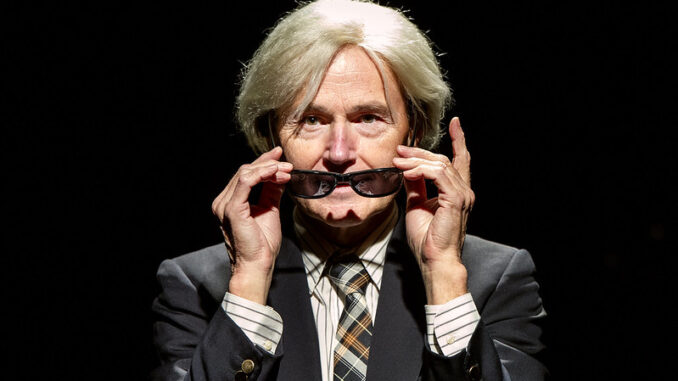
As preparation for seeing the world premiere of Andy Warhol in Iran, commissioned and presented by Barrington Stage Company in Pittsfield, Massachusetts, I watched a few episodes of Ryan Murphy’s new Netflix documentary series, The Andy Warhol Diaries. Within a just few minutes of this two-hander, it seemed likely that playwright Brent Askari had prepared to write this piece of theater by reading The Andy Warhol Diaries, the artist’s posthumously published journals—dictated on daily telephone calls to editor Pat Hackett—a voluminous book that covers the details of Warhol’s life after he was shot by wanna-be celebrity Valerie Solanas, a Warhol Factory habitué.
As we immediately learn in both the Netflix series and the play, Warhol wasn’t keen on public speaking, but he did enjoy talking on the telephone, which provides the central structure for the play: the character of Warhol (played by Henry Stram, who directed last year’s moving BSC production of Eleanor) asks the audience to pretend that he’s recounting an episode from his life to us over the phone. This conceit comes in handy as throughout the piece, Warhol breaks the fourth wall to address the audience and provide background on specific moments in the narrative.
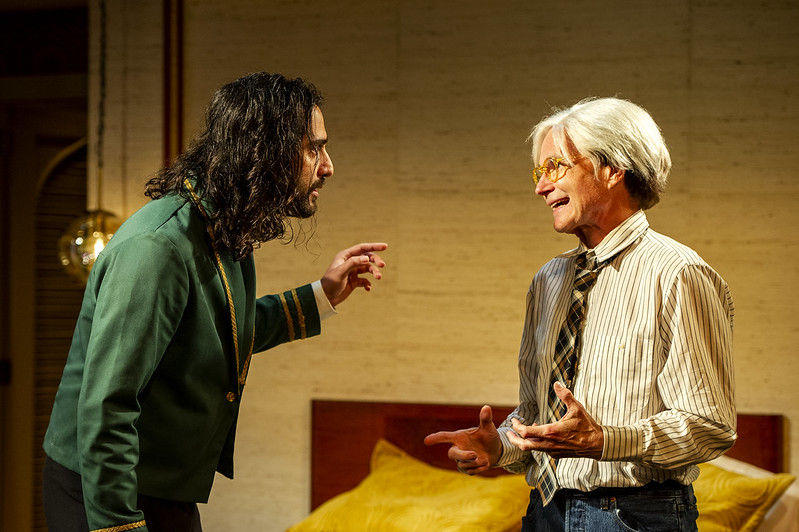
The play takes place in the Tehran Hilton, in the summer of 1976, where Warhol is holed up before taking Polaroid photos of the Shah of Iran’s wife, Empress Farah Pahlavi. This backdrop is true—Warhol did travel to Iran upon being commissioned to paint the Empress’s portrait—but the story that unfolds is fiction, albeit with its own true-history context.
A knock on the hotel door signals that Warhol’s room service order of caviar (at nine dollars per half pound, irresistible to the luxury-loving artist) has arrived. Farhad, seemingly a hotel employee, enters the room and sets up the caviar, but then pulls out a gun and tells Warhol that he is being kidnapped by a group of Iranians opposed to the Shah’s regime.
The ensuing narrative includes Farhad providing concise history of colonialism and foreign interference in Persia—later Iran—up to the reign of the Shah (who maintains a brutal intelligence and secret police organization called SAVAK, established with help from the CIA and Mossad) and Warhol’s frantic attempts to extract himself from this dangerous situation. In the course of the play, commonalities between captive and would-be kidnapper are revealed and each character gains empathy for the other.
One key concept raised in the play is the interplay between art and politics. Warhol tries to explain that he’s the wrong kind of target because he is apolitical; to him, “Politics is so abstract”, he says a few times. Farhad points out that whatever his feelings, Warhol is deeply involved in politics, because by painting portraits of the world’s dictators and despots—a decision Warhol and his business team made so that they could rake in a lot of money from multiple copies of these commissions their rich subjects would demand—he glamorizes and aggrandizes them.
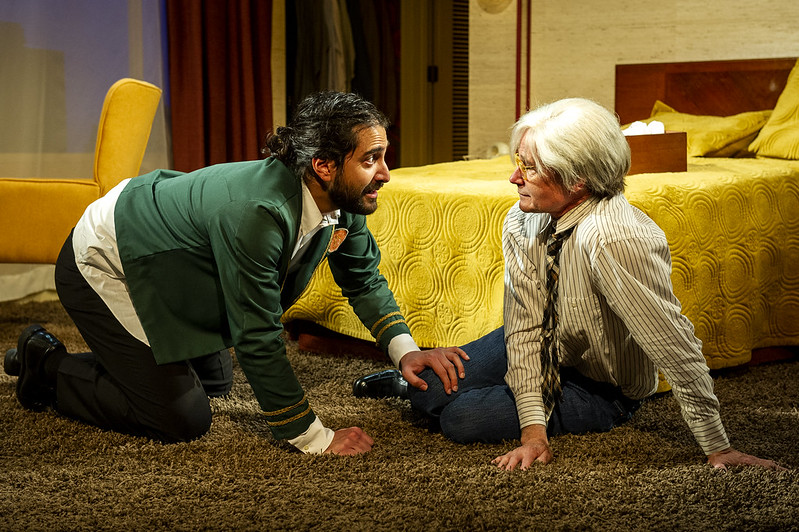
When Warhol offers to pay Farhad not to kidnap him, Farhad explains that the reason for kidnapping arguably the world’s most famous artist is not to to get money to buy more guns and cars, but for publicity, to gain attention for his group’s fight for human rights, to combat the Shah’s use of torture and intimidation. Farhad throws the phrase for which Warhol is most known back at the artist, saying his group wants its 15 minutes of fame for their cause.
As Warhol, Stram convincingly assumes the artist’s signature look and mannerisms, alternating between fear and empathy, with occasional, surprisingly perceptive observations that give this play its turning points. Nima Rakhshanifar is excellent as Farhad as he shifts from threatening to compassionate to panic. His character effectively gains the audience’s sympathy—for both his personal story and his cause— even as we know his kidnapping attempt is doomed to fail.
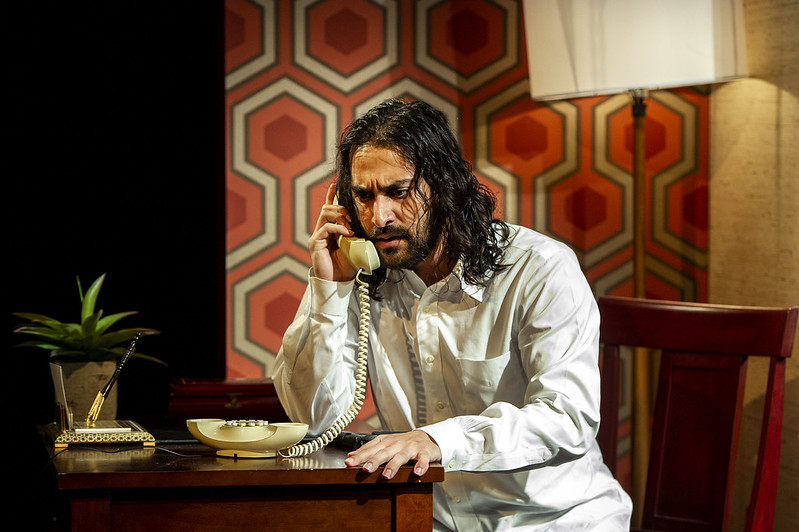
The scenic design by Brian Prather is a knockout; his mid-century hotel room in the Tehran Hilton—with its earthy orange and yellow hues, geometric patterns, and orb-like pendant lights—neatly indicates the time period. The picture window and blank wall above the bed serve as screens during the play’s asides to the audience, as both Warhol and Farhad break the fourth wall to deliver brief historical interludes.
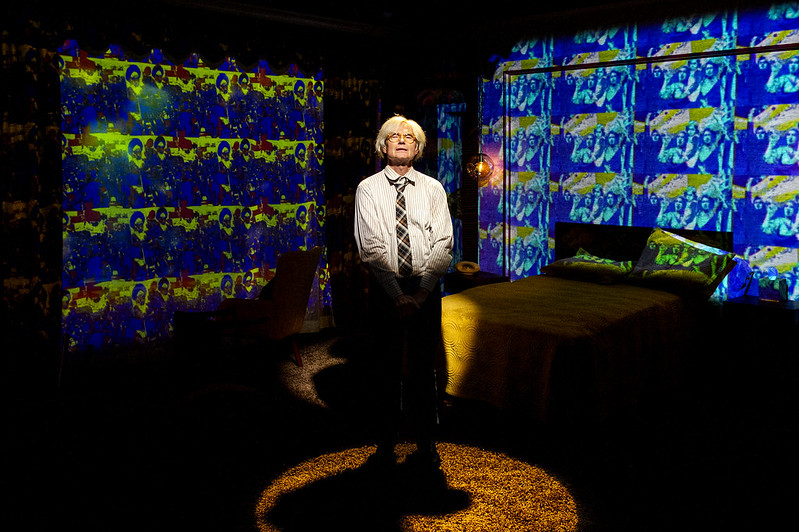
Andy Warhol in Iran is Barrington Stage Company’s first play of the Berkshires summer season, and the first production at BSC’s St. Germain Stage since the start of the pandemic. It’s a great pick to kick off the season, with its mix of action, ideas, tension, and humor. Catch it in Pittsfield, Massachusetts, through June 25.
Photos by Daniel Rayder, courtesy of Barrington Stage Company

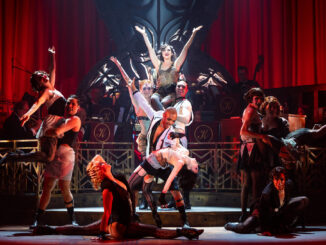

Be the first to comment